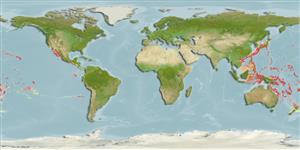Teleostei (teleosts) >
Eupercaria/misc (Various families in series Eupercaria) >
Emmelichthyidae (Rovers)
Etymology: Emmelichthys: Greek, emmelyes, -es, -es = harmonious + Greek, ichthys = fish + Greek,ops = appearance (Ref. 45335).
Eponymy: Dr Paul James Struhsaker (1935–2018) was a fishery biologist and ichthyologist. [...] (Ref. 128868), visit book page.
More on authors: Heemstra & Randall.
Environment: milieu / climate zone / depth range / distribution range
Ecology
Marine; benthopelagic; depth range 180 - 428 m (Ref. 5515). Temperate
Western Central Pacific : Pacific coast of southern Japan, the northern part of the Kyushu-Palau Ridge, Hawaiian Islands, and Australia. Reported from Malaysia (Ref. 5756).
Size / Weight / Age
Maturity: Lm ? range ? - ? cm
Max length : 30.0 cm SL male/unsexed; (Ref. 559)
Found on the continental shelf (Ref. 75154).
Life cycle and mating behavior
Maturity | Reproduction | Spawning | Eggs | Fecundity | Larvae
Masuda, H., K. Amaoka, C. Araga, T. Uyeno and T. Yoshino, 1984. The fishes of the Japanese Archipelago. Vol. 1. Tokai University Press, Tokyo, Japan. 437 p. (text). (Ref. 559)
IUCN Red List Status (Ref. 130435: Version 2024-1)
Threat to humans
Harmless
Human uses
Fisheries: commercial
Tools
Special reports
Download XML
Internet sources
Estimates based on models
Preferred temperature (Ref.
123201): 1.9 - 19.2, mean 13.5 °C (based on 111 cells).
Phylogenetic diversity index (Ref.
82804): PD
50 = 0.5156 [Uniqueness, from 0.5 = low to 2.0 = high].
Bayesian length-weight: a=0.01660 (0.00626 - 0.04399), b=2.99 (2.76 - 3.22), in cm total length, based on LWR estimates for this (Sub)family-body shape (Ref.
93245).
Trophic level (Ref.
69278): 3.4 ±0.45 se; based on food items.
Resilience (Ref.
120179): Medium, minimum population doubling time 1.4 - 4.4 years (Assuming tmax > 3).
Fishing Vulnerability (Ref.
59153): Low to moderate vulnerability (27 of 100).
